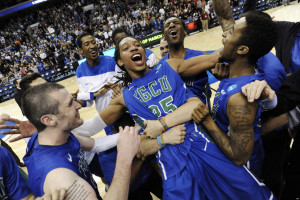
Photo Credit – AP/Michael Perez
Unfortunately, in the time since my most recent post, college basketball lost two giants. Former University of North coach Dean Smith passed away on February and former UNLV coach Jerry Tarkanian passed away on February 11. I encourage you to read others’ magnificent words on Dean Smith, civil rights hero, and Tark, an all-time great coach and character.
On March 24, 2013, Andy Enfield’s Florida Gulf Coast University Eagles captured the hearts and imaginations of tournament-watching America with thunderous dunks, bizarre celebrations, and a set of relatively easy tournament victories over Georgetown and San Diego State University. They became the first 15-seed to play in the tournament’s second weekend, and their success landed Andy Enfield a lavish contract from USC only weeks later. The list of memorable NCAA Tournament Cinderella stories doesn’t begin or end with Florida Gulf Coast. Last season, Mercer upended Duke. George Mason stormed to the Final Four as an 11-seed in 2006. Butler, VCU, Wichita State, and Gonzaga have all established themselves as formidable programs after years of winning tournament games from lower seeds. You can bank every year on a low-seed mid or low conference team making tournament headlines and busting brackets. As thoughtful analysts, it’s our job to ask, “Are these occurrences completely random?”
To answer this question, I reviewed four years worth of tournament results and team profiles from KenPom in hopes of finding similarities and building a profile for future Cinderellas. In this time frame, 16 teams[1] from non-power conferences or worse, seeded 11th or lower won games in the Round of 64. Virginia Commonwealth University and Harvard both accomplished this feat twice, and the range of teams, from lowly Norfolk State and Florida Gulf Coast to tournament regulars Richmond and Dayton, speak to the tenuous nature of predicting first round upsets. Of course, not all 16 teams shared one singular trait, but two tempo-dependent defensive statistics proved to be the strongest indicators of low-seed success in the NCAA Tournament.
Conventional wisdom has it that lower seeded teams must have some combination of experience, height, or deadly 3-point accuracy, preferably all three. Logic dictates that underdog teams need something Goliaths can’t take away, plus a little luck to score a tournament upset. Evidence actually bears this out nicely. Richmond, for example, a 12-seed who beat Vanderbilt in round one, ranked in the top 50 of all three categories. Last years’ Mercer squad had the 5th most experiences team in Division I basketball, with a serviceable average height of 77.5,” and they shot nearly 39% from 3.
If we were to build a Nate Silver-style model to predict Cinderellas, experience, height, and 3-point percentage seems like a great place to start, but it still wouldn’t account for the likes of Norfolk State, Ohio University, or LaSalle. Those three young, poor shooting teams surprised major conference schools. Ohio and LaSalle both even won multiple tournament games. What did these teams have in common? They ranked highly in two defensive categories: turnover percentage defense and steal percentage. In fact, Cinderella teams more frequently rank highly in turnover percentage defense and steal percentage than they do in experience, height, and 3-point percentage.
VCU introduced the basketball world to Havoc – an effective full court press defense – and exposed the dirty little secret of underdog teams: forcing turnovers at a high rate, particularly steals that lead to easy baskets, leads to more tournament wins than the widely publicized height-experience-3 triumvirate. Harvard, Stephen F. Austin, Morehead State, Gonzaga, and our heroes from Florida Gulf Coast all relied on these defensive metrics to build successful tournament teams. The world found itself so infatuated with the coaches, and the dunks, and the personalities, that it overlooked a foundational feature of defenses that can swing the outcome of close, high pressure games in a one-and done tournament.
Lower-seeded teams, by definition are flawed or untested. The beauty of this turnover/steal percentage explanation lies in the fact that teams can simultaneously steal the ball frequently enough to create wins, but play very bad defense overall. Florida Gulf Coast ranked 109th in Adjusted Defensive Efficiency, but 24th nationally in steal percentage. The steal, and the ability to force turnovers, writ large, translates better than 3-point shooting and more consistently than height or experience for lower seeded teams in the tournament setting. This season, when we look for bracket busters, Cinderellas, and the next Dunk City, we should start with turnover percentage defense and steal percentage. Next week, I’ll return and scout teams poised to steal the spotlight this March.
[1] 2011 Richmond, Morehead State, VCU, Gonzaga, 2012 VCU, Lehigh, Norfolk State, Ohio University, 2013 LaSalle, Harvard, Florida Gulf Coast, 2014 Stephen F. Austin, Dayton, Harvard, North Dakota State University, and Mercer





